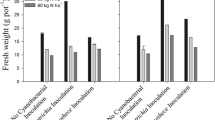Summary
Snails and nematodes, the potential cyanobacterial grazers, differ in their choice for cyanobacterial diet. Snails prefer non-mucilaginous forms while nematodes prefer mucilaginous forms. Such differences in feeding choice between the cyanobacteria suggests that it may not be possible to select strains of diazotrophic cyanobacteria that are resistant to all grazers. The potential consumption of cyanobacteria at an average field density of 20,000 snails ha−1 was estimated to be about 50 kg (fresh weight) ha−1 day−1. Dorylamus sp. was most dominant nematode associated with cyanobacterial consumption. Phytoextracts of neem (Azadirachta indica), bel (Aegle marmelos) and tobacco (Nicotiana tabacum) were effective in controlling these cyanobacterial grazers. The minimum concentration of neem, bel and tobacco phytoextract in water for 100 % mortality of snails were 0.1, 2.0 and 0.05%, respectively. However, trepellent level was only 0.01% for neem and tobacco phytoextract. Complete mortality of nematode (Dorylamus spp.) required a higher concentration level (2%) even in the most effective tobacco phytoextract. Lower levels of phytoextract (0.1%) were found to stimulate growth and nitrogen fixation of cyanobacteria. Application of these plant biomasses resulted in significant increase in cyanobacterial acetylene-reducing activity (ARA) and rice yield and a significant decrease in snail and nematode population. Augmentation of cyanobacterial acetylene-reducing activity was two to three times higher in comparison to the control in both the years of experimentation. Rice yield also increased between 3.8 and 58.5% over the control, depending on the quantity and nature of plant biomass. Tobacco waste was significantly superior in comparison to neem and bel biomass as carrier of cyanobacterial culture.
Similar content being viewed by others
References
M.A. Aziz M.A. Hashem (2004) ArticleTitleRole of cyanobacteria on yield of rice in saline soil Pakistan Journal of Biological Sciences 7 309–311
E.W. Becker (1994) Photobioreactors: production systems for phototrophic microorganisms Baddiley Sir James N.H. Carey I.T. Higgins W.G. Polter (Eds) Microalgae: Biotechnology and Microbiology Cambridge University Press Cambridge 291–299
R.N. Bisoyi P.K. Singh (1988) ArticleTitleEffect of phosphorus fertilization on blue-green algal inoculum production and nitrogen yield under field condition Biology Fertility of Soils 5 338–343 Occurrence Handle1:CAS:528:DyaL1cXitVersrY%3D
P.K. Chonkar K.C. Mishra (1978) ArticleTitlePossible utilization of neem cake for inhibiting nitrification in soil Journal of the Indian Society for Soil Science 26 90–92
C. Devkumar B.K. Goswami (1992) ArticleTitleNeematicidal principles from neem isolation and bioassay of some meliacins Journal of Pesticide Residues 4 79–84
S.K. Goyal B.V. Nagpal Veena T.S. Marwaha (1997) ArticleTitleAn improved method for production of algal biofertilizer Indian Journal of Agricultural Sciences 67 314–15
I.F. Grant A.C. Tirol T. Aziz I. Watanabe (1983) ArticleTitleRegulation of invertebrate grazers as a means to enhance biomass and nitrogen fixation of cyanophyceae in wetland rice fields Soil Science Society of America Journal 47 669–675 Occurrence Handle10.2136/sssaj1983.03615995004700040013x
P. Irisarri S. Gonnet J. Monza (2001) ArticleTitleCyanobacteria in Uruguayan rice fields: diversity, nitrogen fixing ability and tolerance to herbicides and combined nitrogen Journal of Biotechnology 91 95–103 Occurrence Handle10.1016/S0168-1656(01)00334-0 Occurrence Handle1:CAS:528:DC%2BD3MXmvVKltL8%3D
M.L. Jackson (1973) Soil Chemical Analysis Prentice Hall of India Ltd New Delhi
M.N. Jha A.N. Prasad S.K. Mishra (2004) ArticleTitleFeasibility of soil based cyanobacterial culture Asian Journal of Microbiology Biotechnology and Environmental Sciences 6 21–24
S. Kannaiyan (2000) Biofertilizer Technology and Quality Control Publication Directorate, Tamil Nadu Agric. Univ. Coimbatore Coimbatore, India 256
B.D. Kaushik R. Prasanna (1998) NoChapterTitle P.K. Singh Pavvi Sunil (Eds) Blue green algal biofertilizer for rice – A technology Venus Printers & Publishers New Delhi 28–31
P. Malliga L. Uma G. Subramanian (1996) ArticleTitleLignolytic activity of the cyanobacterium Anabaena azollae ML 2 and the value of coir waste as a carrier for BGA biofertilizer Microbios 86 175–183 Occurrence Handle1:CAS:528:DyaK28XmsFeku7g%3D
G. McKinney (1941) ArticleTitleAbsorption of light by chlorophyll solution Journal of Biological Chemistry 140 315–322
A. Mishra S.P. Adhikary (1997) ArticleTitleEffect of different neem preparations on growth, protein content nitrogen fixation and extracellular amino acids of Anabaena variabilis, 44147 Phykos 36 73–80 Occurrence Handle1:CAS:528:DyaK1cXjslemur4%3D
P.M. Reddy P.A. Roger (1988) ArticleTitleDynamics of algal populations and acetylene reducing activity in five in rice soils inoculated with blue-green algae Biology and Fertility of Soils 6 14–21 Occurrence Handle10.1007/BF00257914
P.A. Reynand B. Metting (1988) ArticleTitleColonization potential of cyanobacteria on temperate irrigated soils of Washington State, USA Biology Agriculture Horticulture 5 197–208
Roger, P.A. & Kulasooriya, S.A. 1980. Blue-Green Algae and Rice. In: , . Philippines: Los Banos, International Rice Research Institute.
S.K. Sinha D.C. Verma C.P. Dwivedi (2002) ArticleTitleRole of green manure (Sesbania rostrata) and biofertilizers (Blue green algae and Azotobacter) in rice-wheat cropping system in state of Uttar Pradesh, India Physiology and Molecular Biology of Plants 8 105–110
A.C. Tirol S.T. Santiago I. Watanabe (1981) ArticleTitleEffect of the insecticide carbofuran on microbial activities in flooded soil Journal of Pesticide Science 69 83–89
G.S. Venkataraman (1968) ArticleTitleAlgalization Phykos 59 167–174
Venkataraman, G.S. 1979. Algal inoculation of rice fields. In: , ed. Los Banos pp. 311–321. Philippines: International Rice Research Institute.
A. Watanabe R. Ito J. Sasa (1955) ArticleTitleMicro-algae as a source of nutrients for daphnids Journal of General and Applied Microbiology 1 137–141
J.T. Wilson S. Greene M. Alexander (1980) ArticleTitleEffect of microcrustaceans on blue-green algae in flooded soil Soil Biology & Biochemistry 129 237–240
Y.G. Yanni (1991) ArticleTitleEfficiency of rice fertilization schedules including cyanobacteria under soil application of phosphate and molybdate World Journal of Microbiology and Biotechnology 7 415–418
Author information
Authors and Affiliations
Corresponding author
Rights and permissions
About this article
Cite this article
Jha, M.N., Prasad, A.N. Useful Carriers for Cyanobacteria: Their Response to Cyanobacterial Growth, Acetylene-Reductase Activity, Cyanobacterial Grazers and Paddy Yield in Calcareous Soil. World J Microbiol Biotechnol 21, 1521–1527 (2005). https://doi.org/10.1007/s11274-005-7388-x
Received:
Accepted:
Issue Date:
DOI: https://doi.org/10.1007/s11274-005-7388-x




